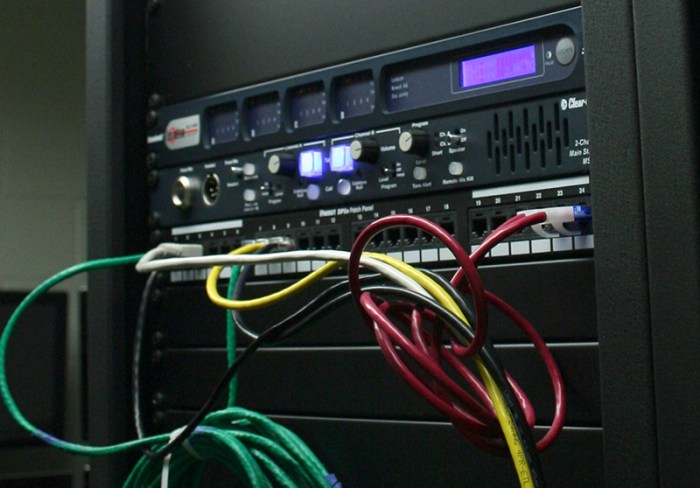As audio video network design best practices take center stage, we delve into a comprehensive guide that empowers you to craft robust and seamless networks. This discourse unveils the intricacies of network assessment, design principles, equipment selection, management, monitoring, and security, arming you with the knowledge to orchestrate exceptional audio-visual experiences.
Prepare to navigate the complexities of audio video network design with confidence. Our exploration begins with a thorough assessment of your existing infrastructure, laying the foundation for a network that meets the demands of your audio-visual applications. We’ll delve into the principles of scalability, redundancy, and security, guiding you towards a network that adapts to your evolving needs while safeguarding your data.
Network Infrastructure Assessment
Evaluating existing network infrastructure is crucial before designing an audio-video network to ensure optimal performance and avoid potential issues. This assessment involves analyzing the network’s capacity, latency, and reliability to determine if it can support the demands of audio-video applications.
Best practices for assessing network capacity include conducting bandwidth tests to measure the available bandwidth and identifying any bottlenecks or congestion points. Latency assessment involves measuring the time it takes for data packets to travel across the network, which is critical for real-time audio-video applications. Reliability assessment focuses on evaluating the network’s stability and uptime, ensuring minimal packet loss and jitter.
Tools and Techniques, Audio video network design best practices
Network assessments can be conducted using various tools and techniques, including:
- Network monitoring tools to track network performance metrics such as bandwidth utilization, latency, and packet loss.
- Bandwidth testing tools to measure available bandwidth and identify bottlenecks.
- Latency testing tools to measure the time it takes for data packets to travel across the network.
- Packet capture tools to analyze network traffic and identify potential issues.
Network Design Principles: Audio Video Network Design Best Practices
The design of an audio-video network should adhere to specific principles to ensure optimal performance and reliability. These principles encompass scalability, redundancy, security, and privacy.
Scalability and Flexibility
Scalability and flexibility are crucial in audio-video network design to accommodate future growth and changing requirements. The network should be designed to handle increased bandwidth demands, support additional devices, and adapt to new technologies and applications without requiring major overhauls.
- Modular architecture allows for easy expansion and reconfiguration.
- Virtualization and software-defined networking (SDN) provide flexibility and agility.
Redundancy and Fault Tolerance
Redundancy and fault tolerance are essential to minimize downtime and ensure continuous operation. The network should incorporate multiple paths, backup systems, and failover mechanisms to prevent single points of failure.
- Dual links and redundant switches provide alternative paths for data transmission.
- Uninterruptible power supplies (UPS) and backup generators ensure power availability during outages.
Security and Privacy
Security and privacy are paramount in audio-video network design to protect sensitive data and prevent unauthorized access. The network should implement robust security measures to safeguard against cyber threats and maintain data confidentiality.
- Encryption and authentication protocols protect data in transit and at rest.
- Firewalls and intrusion detection systems prevent unauthorized access and malicious attacks.
Suitable Network Topologies
Various network topologies can be used for audio-video applications, each with its own advantages and disadvantages.
- Star Topology: A central hub or switch connects all devices in a star-shaped pattern, providing simplicity and scalability.
- Ring Topology: Devices are connected in a circular fashion, creating a redundant path for data transmission.
- Bus Topology: All devices are connected to a single shared cable, offering low cost but limited scalability.
Equipment Selection and Configuration

Selecting and configuring the appropriate network equipment is critical for ensuring optimal performance in audio-video networks. This includes choosing the right switches, routers, and firewalls, as well as configuring them for maximum efficiency.
Switches
Switches are responsible for connecting devices within a network and forwarding data packets between them. In audio-video networks, switches should be selected based on their port density, bandwidth, and latency. Switches with higher port density allow for more devices to be connected, while switches with higher bandwidth and lower latency ensure faster and more reliable data transmission.
Routers
Routers connect different networks and are responsible for directing traffic between them. In audio-video networks, routers should be selected based on their routing capabilities, such as static routing or dynamic routing protocols. Routers should also be configured to prioritize audio-video traffic to ensure seamless transmission.
Firewalls
Firewalls protect networks from unauthorized access and malicious attacks. In audio-video networks, firewalls should be configured to allow only authorized traffic while blocking potential threats. Firewalls can also be used to create separate network segments for different types of traffic, such as audio and video, to enhance security and performance.
Best Practices for Equipment Placement and Cabling
The placement of network equipment and the cabling used to connect them can significantly impact network performance. Equipment should be placed in well-ventilated and easily accessible locations to facilitate maintenance and troubleshooting. Cabling should be of high quality and properly installed to minimize signal loss and interference.
Network Management and Monitoring

Ensuring optimal network performance requires ongoing management and monitoring. Proactively identifying and resolving issues is crucial for maintaining network stability, minimizing downtime, and maximizing productivity.
Monitoring Tools and Techniques
Effective network monitoring relies on a combination of tools and techniques:
- Network Management Systems (NMS): Centralized platforms that provide real-time visibility into network performance, fault detection, and configuration management.
- Simple Network Management Protocol (SNMP): A protocol that allows devices to report performance metrics and events to a central management system.
- Performance Monitoring Tools: Software that monitors network traffic, bandwidth utilization, latency, and packet loss.
- Flow Analysis Tools: Analyze network traffic patterns to identify potential security threats, performance bottlenecks, and application usage.
Network Security Best Practices

Audio-video networks face unique security challenges due to the high volume of sensitive data they transmit. Implementing robust security measures is crucial to protect this data from unauthorized access and cyber threats.
Firewalls
Firewalls are network security devices that monitor and control incoming and outgoing network traffic based on predefined security rules. They can be configured to block unauthorized access, prevent malicious traffic, and protect against network attacks.
Intrusion Detection Systems
Intrusion detection systems (IDS) monitor network traffic for suspicious activity. They can detect and alert on security breaches, such as unauthorized access attempts, malware infections, and denial-of-service attacks.
Access Control Lists
Access control lists (ACLs) are security mechanisms that restrict access to specific network resources based on user or group identity. They can be used to control who can access audio-video data, devices, and applications.
Data Protection
Protecting audio-video data from unauthorized access and cyber threats is essential. This can be achieved through encryption, data backup, and disaster recovery plans.
Closing Summary
As we conclude our journey into audio video network design best practices, remember that a well-crafted network is the cornerstone of a successful audio-visual experience. By embracing the principles Artikeld in this guide, you’ll be equipped to design, implement, and maintain networks that deliver exceptional performance, reliability, and security. Let your audio-visual creations soar to new heights, unhindered by network constraints. The future of audio video networking lies in your hands, and we’re confident that you’ll master it with the knowledge you’ve gained today.
FAQ Insights
What is the most crucial step in audio video network design?
Network assessment is paramount, as it provides a clear understanding of your existing infrastructure and its capabilities, enabling you to design a network that meets your specific requirements.
How can I ensure the scalability of my audio video network?
Scalability is achieved through careful planning and the use of modular components. Design your network with the ability to easily add or remove devices as your needs evolve.
What are the key security measures for audio video networks?
Implement firewalls, intrusion detection systems, and access control lists to safeguard your network from unauthorized access and cyber threats. Regularly monitor your network for suspicious activity and vulnerabilities.













